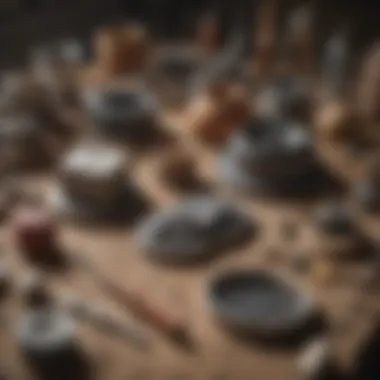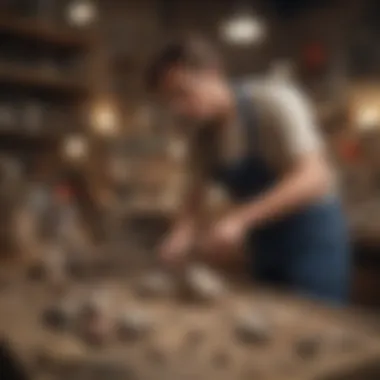Unveiling the Intriguing World of Rock Polishing: A Hobby Lobby Guide


Rock and Fossil Identification
Rock and fossil identification is a foundational aspect of the captivating world of rock polishing, central to understanding the specimens you work with. In this section, we will delve into the types of rocks and fossils commonly encountered, the key characteristics to look for when identifying them, and the essential tools needed for accurate identification.
Types of rocks and fossils
Rocks and fossils come in a vast array of forms, with each type bearing unique properties that influence their appearance and composition. From igneous rocks like granite and basalt to sedimentary rocks such as sandstone and limestone, the variety is astounding. Fossils, on the other hand, offer a glimpse into prehistoric worlds, preserving the remains of ancient living organisms like plants and animals in stone.
Characteristics to look for
When identifying rocks and fossils, attention to detail is key. Factors such as color, texture, hardness, and crystal structure play vital roles in differentiation. For fossils, examining the imprint, shape, and preservation state can offer clues to the organism it once was. Developing a keen eye for these distinguishing features is essential in the accurate identification of specimens.
Tools for identification
Equipping oneself with the proper tools is instrumental in the precise identification of rocks and fossils. A reliable geologist's hammer, a sturdy chisel, and a magnifying glass are indispensable for fieldwork. Additionally, reference books and online resources can provide valuable information on identifying characteristics and key features to look for, enhancing the identification process.
Introduction
Rock polishing is a captivating hobby that unveils the hidden beauty of rough rocks, turning them into polished gems that sparkle. In this article, we will delve into the world of rock polishing at Hobby Lobby, exploring the vast array of tools, techniques, and materials available to enthusiasts. Whether you are a novice looking to start your rock polishing journey or a seasoned collector aiming to refine your skills, this guide will offer valuable insights and practical tips to enhance your experience.
Understanding Rock Polishing
The art of transforming rough rocks into polished gems involves a meticulous process that requires patience and precision. By carefully grinding, sanding, and polishing rocks, enthusiasts can reveal vibrant colors and intricate patterns hidden beneath the surface. This transformative journey from rugged stones to gleaming treasures captivates individuals seeking a creative and rewarding outlet. The therapeutic aspects of rock polishing go beyond the physical act, providing a meditative and calming experience that can reduce stress and cultivate focus.
The art of transforming rough rocks into polished gems
The intricate process of refining rough rocks into luminous gems is a fundamental aspect of rock polishing. It involves utilizing various stages of abrasion and polishing to unveil the innate beauty of each stone. The key characteristic of this process lies in the ability to enhance the natural attributes of rocks, creating distinct pieces that showcase their individuality. The art of transforming rough rocks into polished gems offers enthusiasts the opportunity to engage in a hands-on craft that yields tangible and visually appealing results.
Benefits and therapeutic aspects of rock polishing
Beyond the aesthetic allure of polished gemstones, rock polishing provides numerous benefits and therapeutic effects. Engaging in the process promotes mindfulness and patience, fostering a sense of accomplishment as rough rocks evolve into smooth, lustrous gems. The act of focusing on the intricate details of each stone can also serve as a form of relaxation, allowing individuals to unwind and immerse themselves in a calming, creative pursuit.
Hobby Lobby: A Haven for Rock Polishers
Hobby Lobby stands out as a premier destination for rock polishing enthusiasts, offering a diverse selection of high-quality supplies and materials. From tumbler machines to abrasive grits and polishing compounds, the range of products available at Hobby Lobby caters to both beginners and experienced polishers alike. The convenience of sourcing materials from Hobby Lobby ensures that enthusiasts can access all the necessary tools in one place, streamlining the rock polishing process.
Exploring the range of rock polishing supplies at Hobby Lobby
Hobby Lobby's extensive inventory of rock polishing supplies presents enthusiasts with a plethora of options to choose from, ensuring they can find the perfect tools for their projects. The key characteristic of Hobby Lobby's supplies lies in their durability and effectiveness, enabling polishers to achieve professional-quality results. One unique feature of sourcing materials from Hobby Lobby is the affordability and accessibility of premium products, making it a practical choice for enthusiasts at all skill levels.


Benefits of sourcing materials from Hobby Lobby
Choosing to procure rock polishing materials from Hobby Lobby offers several advantages, including the assurance of superior quality and reliability. By opting for Hobby Lobby's offerings, enthusiasts can have confidence in the effectiveness and consistency of the products, enhancing the overall rock polishing experience. Additionally, the accessibility and expert guidance provided by Hobby Lobby staff contribute to a seamless and gratifying journey into the world of rock polishing.
Getting Started with Rock Polishing
In this segment of the article, we embark on the crucial phase of delving into the world of rock polishing. Getting started is the gateway to a fulfilling journey where enthusiasts are introduced to the essential tools, methods, and considerations necessary for a successful rock polishing experience. This section acts as the foundation, setting the stage for individuals to immerse themselves in the art of transforming rough rocks into polished gems efficiently and effectively. It serves as a comprehensive guide for both novices and seasoned hobbyists, emphasizing the significance of starting correctly to maximize the results and enjoyment derived from the craft.
Essential Tools and Equipment
Tumbler machines and their functions
When it comes to essential tools for rock polishing, tumbler machines play a pivotal role. These machines are designed to execute a series of abrasive processes on rocks, resulting in their transformation from rough to polished state. The key characteristic of tumbler machines lies in their ability to provide a controlled environment for the tumbling process, ensuring consistent and uniform polishing across all rocks processed. The unique feature of these machines is their versatility, allowing users to choose between different tumbling speeds and settings based on the rocks being polished. This flexibility is advantageous as it caters to various rock types and textures, enhancing the overall polishing experience.
Abrasive grits and polishing compounds
Another essential component in rock polishing is the use of abrasive grits and polishing compounds. These substances play a crucial role in the polishing process by facilitating the abrasion and smoothing of rough surfaces on rocks. The key characteristic of abrasive grits and polishing compounds is their varying degrees of coarseness, allowing users to progress through different stages of polishing from rough grinding to fine finishing. Their unique feature lies in their ability to enhance the luster and shine of rocks effectively, resulting in a high-quality polished finish. While these substances offer remarkable benefits in achieving polished gems, users need to exercise caution in handling them to avoid potential disadvantages such as skin irritation or inhalation risks.
Selecting the Right Rocks
Identifying suitable rocks for polishing
Selecting the right rocks for polishing is a critical aspect that significantly impacts the outcome of the polishing process. Identifying suitable rocks involves recognizing their hardness, texture, and suitability for tumbling. The key characteristic of suitable rocks is their ability to withstand the tumbling process without disintegrating or breaking down prematurely. This feature makes them an excellent choice for rock polishing, ensuring a successful transformation from rough to polished state. However, users must be aware of the unique feature of different rock types to achieve optimal results and avoid potential disadvantages such as wasted time and resources.
Avoiding rocks that are not ideal for tumbling
Conversely, avoiding rocks that are not ideal for tumbling is equally important in the rock polishing journey. These rocks may be too soft, porous, or fragile to withstand the tumbling process, resulting in unsatisfactory outcomes or damage to the equipment. The key characteristic of rocks unsuitable for tumbling is their potential to disintegrate or crumble during polishing, leading to inefficiency and disappointment. It is crucial for enthusiasts to identify and exclude these rocks from their selection to ensure a smooth and successful polishing experience, thereby minimizing the disadvantages associated with improper rock choices.
Safety Precautions
Protective gear for rock polishing
The safety aspect of rock polishing cannot be overstated, making protective gear a vital component of the process. The key characteristic of protective gear lies in its ability to safeguard users from potential injuries or hazards while engaging in rock polishing activities. Usin sub-comment parsing limitation reached, please continue writing in another comment box
Advanced Rock Polishing Techniques
In the realm of rock polishing, advanced techniques play a pivotal role in elevating the quality and luster of the final product, resonating deeply with enthusiasts keen on honing their craft. The mastery of advanced techniques signifies a shift towards achieving superior results, delving into the nuances of polishing that set seasoned polishers apart. Understanding the intricacies of advanced rock polishing techniques is a gateway to unlocking the full potential of this art form, allowing individuals to explore new horizons and push the boundaries of creativity.
Multi-Stage Polishing Process


Rough Grinding Stage
The rough grinding stage stands as the foundation of the entire polishing process, where raw stones undergo initial shaping and smoothing through coarse abrasives. This phase is crucial in removing surface imperfections and irregularities, preparing the rocks for the subsequent polishing stages. The rough grinding stage is characterized by its abrasiveness and efficiency in rapidly transforming rough rocks into refined forms, laying the groundwork for a flawless finish. While demanding in terms of grit usage, this stage ensures that the following phases proceed seamlessly, setting a solid basis for achieving desired results.
Fine Grit Polishing Stage
Transitioning to the fine grit polishing stage marks a significant step towards enhancing the smoothness and sheen of the rocks. Finer abrasives are employed during this phase, meticulously refining the surfaces while beginning to unveil the inherent beauty of the stones. The fine grit polishing stage is renowned for its ability to bring out the colors and patterns of the rocks with precision, infusing a subtle radiance that hints at the brilliance of the final polish. Despite requiring meticulous attention to detail, this stage refines the rocks to a degree where they start exhibiting a polished appearance, laying the groundwork for the ultimate transformation.
Final Polish for a Glossy Finish
The final polish serves as the culmination of the multi-stage polishing process, bestowing a glossy finish that encapsulates the essence of rock polishing. Employing polishing compounds and buffing techniques, this stage aims to achieve a mirror-like shine on the rocks, accentuating their textures and colors to perfection. The final polish elevates the visual appeal of the rocks to a dazzling level, showcasing the culmination of effort, skill, and artistry invested throughout the polishing journey. While requiring patience and precision, this stage rewards polishers with a sense of achievement as they witness the metamorphosis of rough stones into resplendent gems.
Experimenting with Different Rock Types
Discover the Unique Patterns and Colors in Different Rocks
Exploring various rock types paves the way for a journey of discovery, where each specimen reveals distinct patterns and colors waiting to be unveiled. By observing the intricate details and hues present in different rocks, polishers gain insights into the geological diversity and artistic potential inherent in each specimen. The act of discovering unique patterns and colors fosters a sense of appreciation for the natural world's artistry, urging enthusiasts to delve deeper into the realm of rock polishing to unearth hidden treasures.
Challenges and Rewards of Polishing Specific Rock Types
Embarking on the polishing journey with specific rock types presents a dual challenge and reward, as each variety comes with its intricacies and difficulties to overcome. Navigating the inherent challenges of polishing specific rock types requires patience, skill, and a keen eye for detail, as not all rocks respond to polishing techniques in the same manner. However, overcoming these obstacles brings a sense of accomplishment and expertise, as polishers unravel the unique qualities and characteristics of each rock type, gaining valuable insights and honing their craft in the process.
Maintenance and Care of Equipment
In this section, we delve into the crucial aspect of maintaining and caring for the equipment used in rock polishing. Careful upkeep of these tools is essential to ensure their longevity and optimal performance. Without proper maintenance, the tumbler machines and associated equipment may deteriorate prematurely, hindering the rock polishing process. By implementing regular maintenance routines, enthusiasts can prolong the lifespan of their equipment and achieve consistent results.
Cleaning and Maintaining Tumbler Machines
Tips for extending the lifespan of your tumbler
When it comes to extending the lifespan of your tumbler machine, certain practices can significantly impact its durability and efficiency. Regular cleaning of the tumbler barrel, ensuring all components are free from grit residue, and checking for any signs of wear are crucial steps to prolong its functionality. By following manufacturer guidelines for maintenance intervals and using high-quality abrasive grits and polishing compounds, rock polishers can maximize the tumbler's lifespan.
Preventing common issues with regular maintenance
Preventing common issues through regular maintenance is key to sustaining the tumbler machine's performance. This includes inspecting the drive belt for tension, lubricating moving parts, and checking the motor for any irregularities. By maintaining a log of maintenance activities and addressing issues promptly, enthusiasts can prevent minor problems from escalating, thus minimizing downtime and repair costs.
Storage of Polishing Supplies
In the context of rock polishing, the way polishing supplies are stored can impact their longevity and efficacy. Organizational solutions that provide a designated space for each item, such as containers for abrasive grits, polishing compounds, and various rocks, can streamline the polishing process and prevent mix-ups. By implementing a systematic storage approach, enthusiasts can efficiently access their materials, enhance workflow efficiency, and maintain the quality of their supplies.


Organizational solutions for your rock polishing materials
Effective organizational solutions involve categorizing supplies based on size, type, and frequency of use. Utilizing labeled containers, storage bins, or cabinets can aid in maintaining a clutter-free workspace while safeguarding the supplies from contamination or damage. Establishing a storage system tailored to individual preferences can optimize accessibility and contribute to a conducive environment for rock polishing activities.
Preserving the quality of grits and compounds
Preserving the quality of grits and compounds involves storing them in airtight containers to prevent moisture absorption and degradation. Moisture can compromise the effectiveness of abrasive materials, leading to subpar polishing results. By storing these supplies in a cool, dry place away from direct sunlight, enthusiasts can prolong their shelf life and ensure consistent polishing outcomes over time.
Exploring Creative Possibilities
In this section, we will delve deeper into the realm of creative possibilities that rock polishing at Hobby Lobby offers. Exploring creative avenues not only enriches the overall experience but also allows enthusiasts to showcase their craftsmanship and individuality. By incorporating polished rocks into various crafts, rock enthusiasts can unleash their creativity and transform mundane stones into unique pieces of art.
Incorporating Polished Rocks into Crafts
DIY projects using polished stones
DIY projects using polished stones open up a world of creative expression. These projects enable individuals to personalize their creations and showcase their skills in a tangible form. By choosing stones of different colors and textures, enthusiasts can add a personal touch to their projects, making each piece truly one-of-a-kind. The beauty of DIY projects lies in the opportunity to experiment with various techniques and designs, allowing for endless innovation and customization. While DIY projects can be time-consuming, the sense of accomplishment and pride in creating something unique is immensely rewarding.
Personalizing gifts with custom polished rocks
Personalizing gifts with custom polished rocks adds a special touch to any occasion. Whether it's a birthday, anniversary, or holiday gift, custom polished rocks carry a sense of thoughtfulness and uniqueness that store-bought presents often lack. Enthusiasts can inscribe messages, names, or dates on the stones, making them sentimental keepsakes for the recipient. The act of personalizing gifts with polished rocks not only showcases the giver's creativity but also allows them to imbue the gift with meaning and emotion. While personalizing gifts can require time and effort, the joy of presenting a custom-made creation is incomparable.
Displaying Your Polished Creations
Showcasing polished rocks in unique ways
Showcasing polished rocks in unique ways offers enthusiasts the opportunity to display their creations artistically. By arranging polished stones in intricate patterns or incorporating them into decorative pieces, individuals can create visually stunning displays that capture the beauty of the stones. Displaying polished rocks in unique ways not only elevates their aesthetic appeal but also provides a conversation starter for admirers. The versatility of polished rocks allows for various display options, from elegant arrangements to whimsical designs, catering to different tastes and styles.
Creating a stunning rock collection display
Creating a stunning rock collection display transforms a hobby into a centerpiece of admiration. By curating polished rocks into themed collections or arranging them based on colors and shapes, enthusiasts can create visually striking displays that reflect their passion for rock polishing. A well-organized rock collection display not only accentuates the beauty of the stones but also showcases the collector's dedication and discernment. The process of creating a stunning display can be therapeutic and meditative, offering enthusiasts a serene space to appreciate the natural beauty of their polished creations.
Conclusion
In the realm of rock polishing at Hobby Lobby, the conclusion serves as a pivotal point in this insightful article, encapsulating the essence and significance of embracing the art of transforming rough rocks into polished gems. By reflecting on the journey of metamorphosing ordinary stones into lustrous treasures, artisans gain a profound appreciation for patience, precision, and the therapeutic benefits accrued from this ancient craft. Continuously building upon one's rock polishing skills opens up avenues for creativity and self-expression, fostering a deep connection with the natural world and the treasures it conceals. The conclusion not only marks the end of one project but also signifies the beginning of new possibilities in the captivating world of rock polishing at Hobby Lobby.
Embracing the Art of Rock Polishing
Reflecting on the Journey of Transforming Rocks into Treasures
Delving into the soul-stirring journey of turning rough stones into exquisite polished gems, rock enthusiasts experience a profound sense of connection with the earth's timeless elements. When reflecting on this transformational process, individuals confront the intricate beauty that lies beneath the rugged surface of rocks, appreciating the artistry required to reveal their hidden splendor. The act of revealing the innate patterns, colors, and textures within each rock not only enhances one's patience and attention to detail but also awakens a renewed sense of wonder and admiration for the natural world. Reflecting on this journey of metamorphosis brings a sense of accomplishment and fulfillment, making each polished stone a testament to dedication, artistry, and the endless wonders of nature.
Continuing to Explore and Develop Your Rock Polishing Skills
Continually honing and expanding one's rock polishing skills is vital in the pursuit of excellence and innovation in this age-old craft. By persistently exploring new techniques, materials, and rock types, artisans elevate their ability to transform raw stones into dazzling works of art. The quest for improvement not only refines technical proficiency but also nurtures a spirit of creativity, pushing artisans to experiment with different textures, finishes, and designs. The process of developing rock polishing skills fosters adaptability, resourcefulness, and a keen eye for detail, enabling enthusiasts to push the boundaries of their creativity and create truly unique pieces. Embracing the journey of skill development in rock polishing opens up possibilities for self-expression, artistic growth, and a deeper connection with the art of transforming rocks into cherished treasures.







